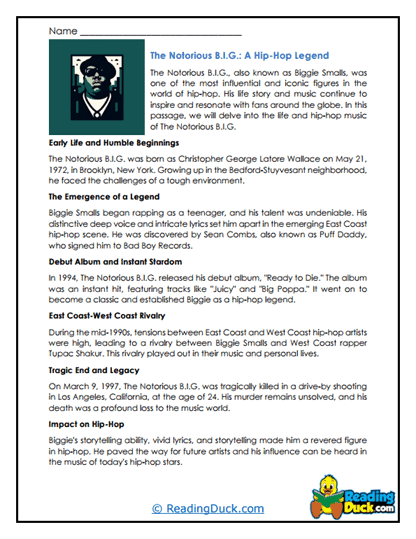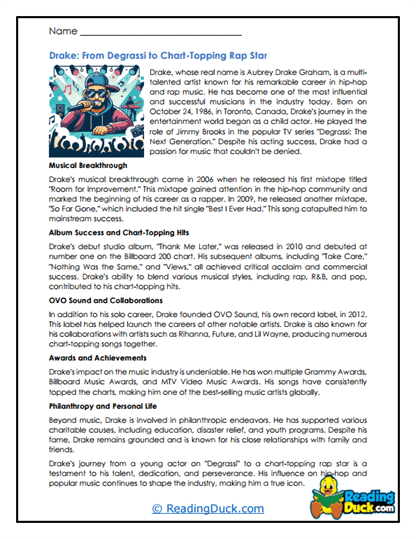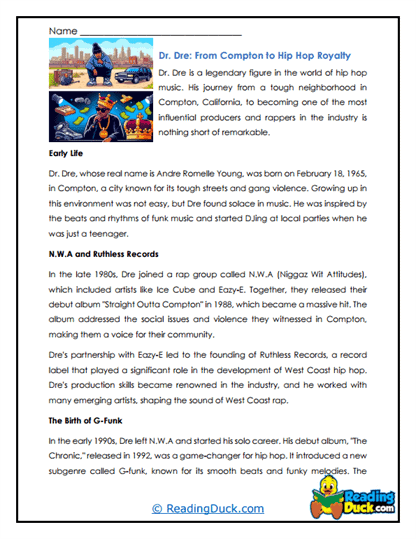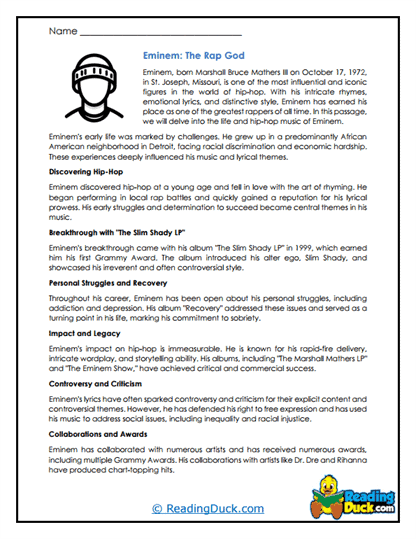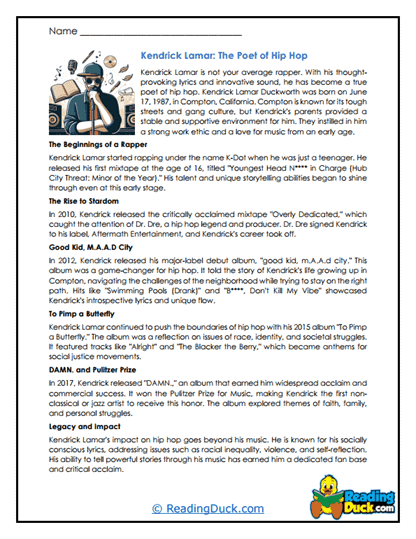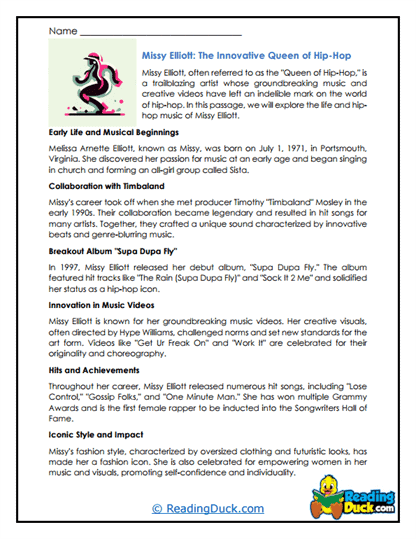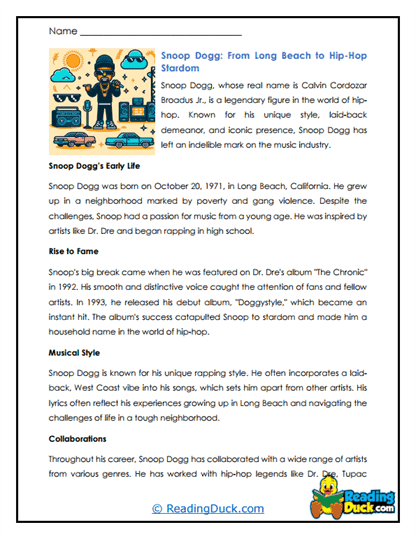Hip Hop Artists Worksheets
About Our Hip Hop Artists Worksheets
Our Hip Hop Artists worksheets provide an engaging and comprehensive exploration of some of the most influential figures in hip hop history. Hip hop is not just a genre of music; it's a cultural movement that has shaped the soundscape of the world with its powerful beats, innovative lyrics, and unique storytelling. These worksheets are designed to help students appreciate the creativity, technical skill, and cultural impact that hip hop artists have had on music and society.
Each topic in our Hip Hop Artists collection contains several worksheet sets, each designed to build students' understanding and connection to the material through a variety of activities. Each worksheet set includes:
- Multiple Choice Questions: These questions assess students' comprehension of the reading passages, focusing on key facts about the artist's life, career, and contributions to hip hop. This format helps reinforce students’ understanding and encourages them to engage with the material in detail.
- Short Answer Questions: This format challenges students to reflect on what they’ve learned by writing their responses in their own words. These questions encourage deeper thinking and help students articulate their thoughts and insights about the artist's influence and style.
- Open-Ended Questions: These questions invite students to explore their personal responses to the material, asking them to express opinions, preferences, or interpretations related to the artist's music and legacy. This format fosters critical thinking and allows students to connect with the content on a more personal level.
Each worksheet set is designed to assess students’ understanding while enhancing their engagement with the topic. An answer key is provided for every question sheet, making it easy for educators to review and evaluate students’ progress. All worksheets are available as PDF files, which can be easily viewed electronically, downloaded, and printed.
The Evolution of a Cultural Movement: Understanding Hip Hop and Its Artists
Hip hop is a genre that began as a form of expression for marginalized communities and has since grown into a global cultural phenomenon. When introducing students to the world of hip hop, it’s essential to highlight how this genre has evolved over time, shaped by the unique voices and experiences of its artists. Hip hop is more than just music; it's a way of life that encompasses art, dance, fashion, and activism.
Key Aspects of Hip Hop Artists:
- The Origins of Hip Hop: Hip hop emerged in the 1970s in the Bronx, New York City, as a response to the social and economic challenges faced by African American and Latino communities. DJs like Kool Herc pioneered the use of breakbeats, while MCs began rhyming over these beats, giving birth to rap music. Understanding the origins of hip hop helps students appreciate its roots in resilience, creativity, and community.
- Pioneers of the Genre: The rise of hip hop is marked by the contributions of pioneering artists who have shaped its sound and expanded its reach. Artists like Grandmaster Flash, Run-D.M.C., and LL Cool J brought hip hop into the mainstream with their innovative styles and powerful messages. These artists not only defined the sound of hip hop but also influenced generations of musicians and activists.
- Modern Hip Hop Icons: Hip hop continues to evolve, with contemporary artists like Kendrick Lamar, Nicki Minaj, and Drake bringing new influences and styles to the genre. These modern stars have broadened the appeal of hip hop, blending elements of other genres like R&B, pop, and rock to create a sound that resonates with a global audience. Understanding the contributions of these artists helps students see how hip hop remains relevant and dynamic in today’s music scene.
- The Role of Lyrics in Hip Hop: One of the defining characteristics of hip hop is its focus on lyrical content. Rappers use their lyrics to tell stories, express emotions, and address social and political issues. Students should explore how hip hop artists use wordplay, metaphors, and rhythm to convey powerful messages and connect with their audiences on a personal level.
- Cultural Impact and Legacy: Beyond the music itself, hip hop artists have had a profound impact on culture. Their music has influenced fashion, language, and even social movements. Artists like Tupac Shakur and Public Enemy used their platforms to speak out against injustice, making hip hop a voice for the voiceless. Recognizing the cultural significance of hip hop helps students see the broader impact of music on society.
- The Evolution of Hip Hop: Hip hop is a genre that is constantly evolving, with new styles and subgenres emerging all the time. From the early days of old-school hip hop to the rise of trap and mumble rap, hip hop artists have continually pushed the boundaries of what the genre can be. Understanding this evolution helps students appreciate the diversity within hip hop and the ways in which it reflects broader trends in music and culture.
By exploring these key aspects of hip hop artists and their contributions to music, students can develop a well-rounded understanding of the genre and its significance. They will learn to appreciate the technical skills, creativity, and cultural impact that hip hop artists bring to the music world. This knowledge not only enhances their musical education but also fosters a deeper connection to the music they listen to and enjoy.
The Importance of Music Education
Music education is essential for students of all ages because it nurtures creativity, enhances cognitive development, and provides a means of emotional expression. Learning about music, whether through playing an instrument, understanding music theory, or studying influential musicians, helps students develop skills that are transferable to other areas of life. It encourages discipline, perseverance, and teamwork, while also improving memory and problem-solving abilities.
Moreover, music education allows students to explore their own creativity and connect with others on a deeper level. It fosters an appreciation for different cultures and histories, as music often reflects the values and experiences of diverse communities. By studying music and the artists who create it, students gain a greater understanding of the world around them, enriching their personal and academic development.
Integrating These Worksheets in a Curriculum
To effectively incorporate our Hip Hop Artists worksheets into your curriculum, here are some tips for teachers and parents:
- Thematic Lessons: Create themed lessons around specific eras or movements within hip hop. For example, explore the Golden Age of Hip Hop, focusing on how artists like Rakim, A Tribe Called Quest, and N.W.A. helped shape the genre.
- Comparative Analysis: Encourage students to compare and contrast the styles and techniques of different hip hop artists. This could involve examining how the sound of East Coast hip hop differs from West Coast hip hop, or how various artists have addressed similar social issues in their lyrics.
- Interactive Listening Sessions: Pair the worksheets with listening sessions where students can hear the hip hop artists in action. Use audio or video recordings to showcase the musicians discussed in the worksheets, helping students connect the theoretical aspects of their studies with the actual sound and feel of the music.
- Creative Projects: Assign creative projects where students can write their own rap lyrics, analyze the production techniques in their favorite hip hop tracks, or create a presentation on their favorite hip hop artist. These hands-on activities allow students to apply what they’ve learned in a practical and engaging way.
- Cross-Disciplinary Connections: Link the study of hip hop artists with other subjects such as history, social studies, or language arts. For example, discuss how the social and economic conditions of the 1980s influenced the rise of hip hop, or explore the poetic techniques used in rap lyrics.
- Group Discussions: Use the open-ended questions in the worksheets as prompts for group discussions. Encourage students to share their thoughts on the music, the musicians, and the cultural impact of the hip hop artists they are studying. These discussions can help students develop critical thinking skills and learn to articulate their opinions effectively.
- Assessment and Feedback: Use the multiple choice and short answer questions to assess students’ understanding of the material. Provide personalized feedback that highlights their strengths and areas for improvement, helping them grow as both students and music enthusiasts.
By using these strategies, teachers and parents can help students gain a deeper understanding of hip hop, develop critical listening skills, and foster a lifelong appreciation for the genre. The Hip Hop Artists worksheets are a valuable resource that can be integrated into a variety of educational settings, making music history and theory accessible and engaging for all students. Through consistent practice and exploration, students will not only learn about the great hip hop artists of the past and present but also develop a greater appreciation for the art of music itself.
